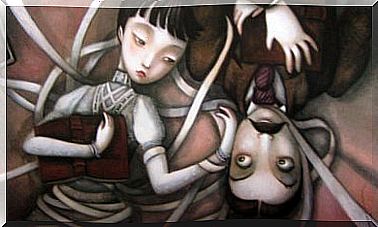The History Of The Symbol Of Psychology (Ψ)
The history of the symbol of psychology contains something mythological and a curious evolution of the term “psi” (Ψ) is not without a certain originality. In its origins, this twenty-third letter of the Greek alphabet ended up being transliterated by the Romans to form the word psyche, which meant butterfly and later evolved into a breath of breeze, breath, spirit and finally ‘ soul’.
All of us who have studied psychology remember that day when when we arrived at the university, the imprint of this symbol appeared almost anywhere. Books, teachers’ offices, informative notes … Also those curious about this science know how to recognize it, to the point that it is already part of that culture of symbols so common in different disciplines such as philosophy and its well-known “fi” ( Φ).
Now, sometimes we stay with the iconography without going any further. Even more, sometimes we assume as certain little urban legends that misrepresent the magic of our origins a bit. Thus, it is very common to hear that the symbol of psychology (Ψ) is a trident, the devil’s trident: no more, no less.
This false theory has its roots in that time when mental illnesses were considered diabolical evils. Disorders that responded to supernatural influences, spells and witchcraft, where man could not help man. Everything was then in the hands of the church and of course, the bonfires. Nothing is further from reality. Let us now see what is the true origin of the symbol of psychology.
The history of the symbol of psychology (Ψ), the science of the soul
In ancient Greek, the word psyche, as we pointed out at the beginning, meant butterfly. This insect also symbolized the breath of life, a breath of wind, a vital breeze … Little by little and also under the influence of the Roman Empire, this word ended up symbolizing the human soul, an idea where the vital force of the human being was integrated or the “ka” of Egyptian culture.
The Greeks and Romans used to hold a very determined view of people’s souls. Within their beliefs, when someone died, that breath, that “ka” that the Egyptians also spoke of, emerged to the outside as in a breath of air. And he did it in the shape of a butterfly. Likewise, in that image there was nothing terrifying, nothing to regret or fear, since the butterfly was a being that represented light, change, hope …
The history of the symbol of psychology therefore assumed the term psyche to later unite it with “logia” (ψυχή and λογία) . In this way, and over time, it went from being etymologically the “science of the soul” to becoming a “science of the mind”, the symbol “Ψ” being its maximum representation.
The myth of Eros (Cupid) and Psyche
In Greek mythology the word “psyche” means more than just butterfly, soul, or mind. Psyche is a goddess, a beautiful creature with butterfly wings who lived one of the most beautiful loves, the one that was immortalized by Apuleius in his Metamorphosis (The Golden Ass).
The story goes that of the three daughters of the king of Anatolia there was a really special one. She was so delicate, attractive and full of joy that the goddess Aphrodite herself despaired when she saw her rival in the young woman. His jealousy was so desperate that he did not hesitate to send his son Eros (Cupid) to shoot him one of his arrows. So that young Psyche would fall for the most vile, ugly and ruthless man in all of Anatolia.
However, something happened not foreseen by Aphrodite. It was his son Eros who fell for Psyche. Thus, the young god, unable to resist, decided to go every night to the girl’s bedroom to conquer her and make her his. So it was. This is how Psyche fell madly in love with a stranger who visited her every night in the dark so that she could not see his face. A god who wanted to preserve his identity, so as not to put an end to that magical idyll.
Yet something happened. When Psyche spoke to her sisters about that relationship, they recommended that she not go ahead if she could not see the face of her mysterious lover. The young woman did so. Taking advantage of the fact that Eros was sleeping in his bed, he brought a lamp closer to illuminate it. When he did this, Aphrodite’s son stormed off in rage at Psyche’s audacity.
Tests of Psyche
Heartbroken, dejected and repentant, the daughter of the king of Anatolia went to Aphrodite for help. Eros’s mother then saw her opportunity to take revenge on her, to eliminate from the world a woman who rivaled the goddess of love in beauty. He proposed 4 tests, four jobs that, if passed, could return Eros’s forgiveness and affection. Now, these companies involved traveling to the underworld, confronting Cerberus, traveling with Charon and later with Hades in order to reach Persephone and then ask her for a bit of her beauty, which she kept in a box.
However, against all odds, the astute Psyche turned out to combine not only beauty, but also wit, bravery and determination. However, just when she managed to circumvent each difficulty and obtain Persephone’s box, the young woman sinned from curiosity and vanity. He decided to open it to see the contents and get a bit of that beauty. It was at that moment that she fell into a trap: the Stygian dream. But a familiar hand snatched that curse from his eyes. A familiar skin comforted her and a hopeful face restored her joy in the second: it was Eros, who, having forgiven her, came to her aid.
The end of this magical couple could not be happier. Aphrodite freed herself from her envy towards her son’s beloved and danced at their wedding. Zeus, for his part, decided to make Psyche immortal, that beautiful and brave woman who with her butterfly wings also represents the symbol of psychology “Ψ”.









